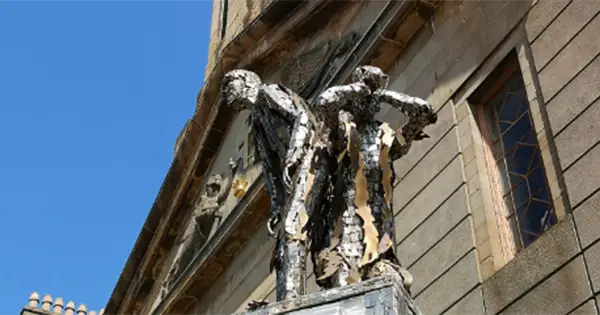A memorial to the Irish people who fled to Scotland during the Great Famine has been unveiled in Glasgow.
The Tower of Silence was created by Irish sculptor John McCarron and took several years of fundraising to finally be ready for display.
It is inscribed with the words ‘An Gorta Mór’ meaning ‘Great Famine’ and is placed in the grounds of St Mary’s Church in Calton, Glasgow. Parish Priest Canon Tom White spoke at the unveiling.
He said: “It seemed natural that this church, which was built by the Irish to shepherd and care for the Irish, would host a living memorial to their memory.
“This memorial here, this tower of silence, will speak volumes, and I’m delighted and grateful to the committee, who pioneered this work, commissioned this work and saw it fruitfully executed to this day.”
The Great Famine is one of the key events in Irish history, particularly regarding the global diaspora.
It is estimated that one million people died and another million were forced to leave to seek futures elsewhere.
There are now hundreds of millions of people scattered all around the world that have Irish heritage and it is one of the reasons that the country is so popular and loved.
Of those that left Ireland during the Famine, around 100,000 went to Scotland to build new lives.
Jeanette Findlay is the Chair of Coiste Cuimhneachain An Gorta Mór, the group that organised the fundraising for the statue.
She said: “Today is our day, the day for the children of those impoverished and brutalised people who managed to reach these shores, to finally see that part of history, that terrible part, acknowledged and remembered in a physical and permanent way.
“So, in that sense, while it is a time for reflection on the awful reality that they endured, it is also a time for celebration that they did endure, they did survive and they, in large part, flourished in this city.
“This memorial should be a reminder to us that we owe it to our own ancestors to be the welcoming community to new arrivals in Glasgow that we wish our ancestors had met all those decades ago, and to treat them as we wish our own had been treated, and were treated, by the honourable few.”
The statue was chosen from three proposed designs. McCarron used a stainless steel column to represent the industrial city of Glasgow, and steel patchwork design to mimic the stone cabins the rural Irish left behind.
The abstract figures atop the statue are a representation of the desperation felt by those people that were forced to leave Ireland.
The monument also displays the final verse of the poem The Stricken Land. It was written by Lady Jane Wilde under the pseudonym Speranza in 1847 right in the midst of the Famine.
Congratulations and thanks to the decidated @GortaMorGla Committee for their work to build this memorial to An Gorta Mór.
A very moving ceremony to unveil The Tower of Silence in it's home in St Mary's in the Calton this afternoon. pic.twitter.com/TJiA8TlTVE
— Alison Thewliss ? (@alisonthewliss) July 25, 2021
